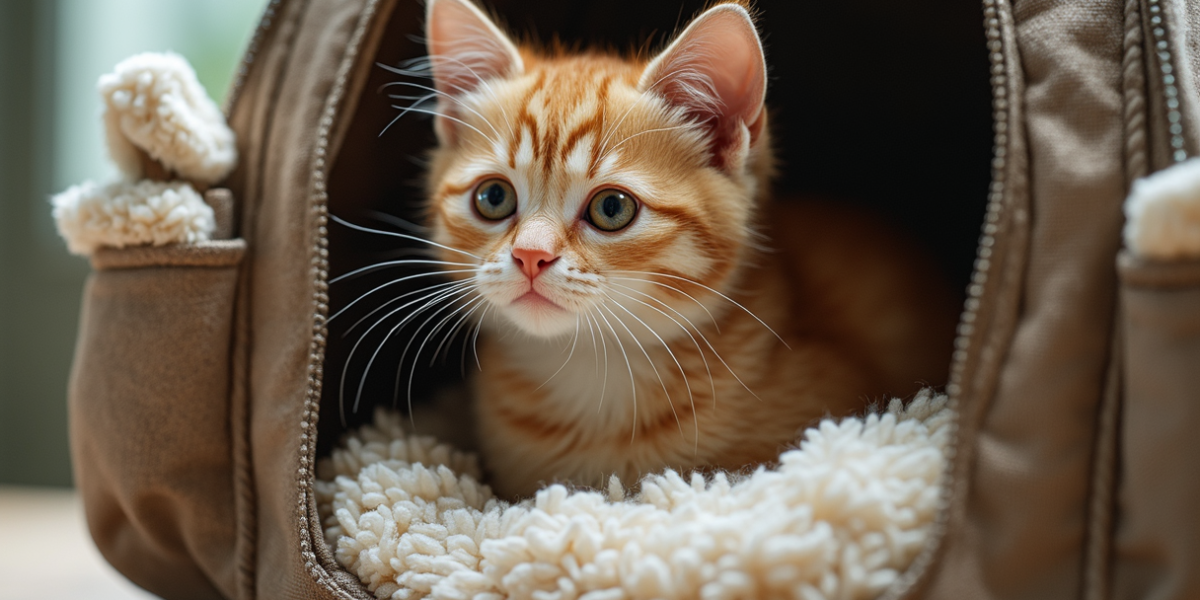Traveling with your cat can be an intimidating trip as much as it can be fun. Whether you’re planning a cross-country road trip or catching a flight to a new destination, traveling with cats requires thoughtful preparation and a little extra care. Cats are known for their independent spirits and sometimes temperamental natures, making it essential to ensure their comfort and safety during your travels. In this guide, we’ll share essential tips to help you navigate the logistics of transporting your furry companion, from selecting the perfect carrier and preparing for the journey, to keeping them calm and entertained along the way. With a bit of planning and patience, you can transform what might seem like a stressful experience into a seamless and enjoyable adventure for both you and your beloved cat. So grab your travel gear and let’s hit the road—your next great adventure awaits!

1. Preparing Your Cat for Travel
Traveling with your feline friend can be an exciting adventure, but preparation is key to ensuring a smooth journey for both you and your cat. Before embarking on your trip, start by acclimating your cat to their carrier. Leave the carrier out in a familiar space with their favorite toys or a soft blanket inside, allowing them to explore it at their leisure. This helps create a sense of security and familiarity, making them more comfortable when it’s time to travel.
Next, schedule a vet visit to ensure your cat is healthy and up-to-date on vaccinations, especially if you plan to travel across state lines. Discuss any potential anxiety your cat may experience during travel, and your veterinarian may recommend calming aids, such as pheromone sprays or natural supplements, to ease stress.
Additionally, practice short car rides with your cat to help them get used to the motion and sounds of travel. Keep the environment calm and quiet during these practice runs to help your cat associate the carrier and travel with positive experiences.
On the day of travel, make sure to pack essential items, including food, water, a leash and harness, and any medications your cat may need. Remember to establish a routine for feeding and bathroom breaks, whether on a road trip or during a flight, to provide structure and comfort amidst the chaos of travel. With proper preparation, you can transform travel time into a positive experience, creating lasting memories on the road or in the air with your beloved companion.
2. Choosing the Right Carrier
Choosing the right carrier for your feline friend is crucial to ensuring a smooth and stress-free travel experience, whether you’re hitting the open road or boarding a flight. The carrier should be a safe and comfortable space that your cat feels secure in, allowing them to rest and relax during the journey.
First and foremost, consider the size of the carrier. It must be large enough for your cat to be able to stand, rotate, and lie down without stress. A carrier that is too small can create anxiety and discomfort, while one that is too large may not provide the sense of security that your cat needs. As a general guideline, the carrier should be just snug enough to give your cat a feeling of enclosure without being restrictive.
Material is another important factor to take into account. Soft-sided carriers are lightweight and often easier to stow away, making them a great choice for air travel. They usually come with mesh panels for ventilation, which is essential for keeping your cat cool and calm. However, if you’re traveling by car, a hard-sided carrier may be preferable as it provides extra protection and stability, especially in the event of sudden stops or sharp turns.
Look for carriers that feature secure latches and sturdy handles. You want to ensure that the carrier will remain closed during travel and can be comfortably carried without fear of slipping from your hands. Additionally, consider carriers that come equipped with removable or washable liners. This will make it easier to maintain a clean environment for your cat throughout the trip.
Finally, try to involve your cat in the selection process. If possible, take them to a pet store and allow them to explore different carriers. You can also make the carrier more inviting by adding familiar blankets or toys, which can help alleviate anxiety. By taking the time to choose the right carrier, you’ll set the stage for a more enjoyable journey for both you and your furry companion!

3. Road Trip Tips for Traveling with Cats
Traveling with your feline friend can transform a road trip into a delightful adventure, but it requires some thoughtful preparation to ensure a smooth journey for both you and your cat. Here are essential tips to keep in mind when hitting the road with your furry companion.
1. Choose the Right Carrier: Begin by selecting a sturdy, comfortable carrier that allows your cat to stand, turn around, and lie down. Look for one with plenty of ventilation and a secure door. Introduce your cat to the carrier well before your trip, allowing them to explore and get accustomed to it. You can even line it with their favorite blanket or a piece of your clothing for added comfort.
2. Prepare for the Journey: Before setting off, familiarize your cat with the car. Take them on short drives to help them acclimate to the noise and motion. On the day of the trip, secure the carrier in a stable position, preferably in the back seat, to minimize movement and prevent distractions while driving.
3. Pack a Travel Kit: Just like any good traveler, your cat will need a travel kit. Include essentials such as food, water, bowls, a leash and harness, waste bags, and any medications they might need. Don’t forget to pack a few of their favorite toys to keep them entertained and ease anxiety during the journey.
4. Plan Regular Breaks: Cats, like humans, need breaks during long trips. Schedule regular stops every 2-3 hours to allow your cat to stretch, use the litter box, and hydrate. Always keep your cat leashed and supervised during stops to prevent escape in unfamiliar environments.
5. Keep Them Calm: If your cat is prone to anxiety, consider using calming products such as pheromone sprays or anxiety wraps. Play soft music in the car to create a soothing atmosphere, and avoid sudden loud noises that might startle them.
6. Monitor Temperature: Ensure the temperature in the car is comfortable, as cats can easily overheat. Never leave your cat alone in a parked car, even for a few minutes, as it can lead to dangerous conditions.
7. Prepare for Overnight Stays: If your road trip involves overnight stays, research pet-friendly accommodations in advance. Bring along familiar items from home to create a sense of security for your cat in new places.
By following these tips, you can create a positive travel experience for your cat that helps them feel safe and comfortable on the road. With a little preparation, your road trip can be a memorable adventure for both you and your furry companion!
4. Airline Regulations and Flight Preparations
Traveling with your feline friend can be a rewarding adventure, but it also requires careful planning, especially when it comes to airline regulations and flight preparations. Before you book your flight, it’s crucial to familiarize yourself with the specific airline’s pet policy, as regulations can vary significantly between carriers. Most airlines allow cats to travel in the cabin, but there are usually size restrictions for pet carriers, typically requiring them to fit under the seat in front of you. Ensure that your cat’s carrier meets these dimensions and is well-ventilated for comfort.
Preparation begins long before you arrive at the airport. Schedule a visit to your veterinarian to ensure your cat is healthy enough for travel and up-to-date on vaccinations. Some airlines may require a health certificate issued by a veterinarian, so it’s wise to check those details ahead of time. Additionally, consider acclimating your cat to the carrier by allowing them to explore it at home, pairing it with treats and toys to create positive associations.
On the day of travel, keep essentials easily accessible—such as your cat’s leash, food, and water—while ensuring your kitty is secure in the carrier. Arrive at the airport early to navigate check-in procedures without the stress of rushing. During the flight, maintain a calm demeanor; cats are sensitive to their owner’s emotions, and a soothing presence can help ease their anxiety. With the right preparations and knowledge of airline regulations, you can ensure that your traveling experience is as smooth and enjoyable as possible for both you and your furry companion.
5. Keeping Your Cat Calm and Entertained During the Journey
Traveling with your feline friend can be a rewarding adventure, but it also comes with its own set of challenges. One of the most crucial aspects of ensuring a smooth journey is keeping your cat calm and entertained during the ride, whether you’re hitting the road or soaring through the skies.
To start, consider creating a cozy and familiar environment in their carrier. Line it with their favorite blanket or a piece of your clothing to provide comfort and a sense of security. Cats are creatures of habit, and familiar scents can significantly reduce anxiety. You might also want to incorporate some of their beloved toys into the carrier; interactive toys like feather wands or crinkly balls can provide a delightful distraction during the trip, keeping their minds engaged.
For long road trips, plan regular breaks to let your cat stretch their legs and explore a safe, enclosed area. Even a few minutes of playtime during these stops can alleviate pent-up energy and reduce restlessness. If you’re flying, check with your airline about pet-friendly policies and ensure your cat has enough room to move comfortably in their carrier.
In addition to physical comfort, consider using calming pheromones or sprays designed specifically for cats, which can help soothe nerves during travel. Certain natural supplements, such as those containing L-theanine or valerian root, may also promote relaxation. Always consult your veterinarian before trying these options to ensure they are appropriate for your cat.
Lastly, keeping your cat entertained can also involve a little creativity. Consider downloading calming music or nature sounds specifically designed for pets to play softly during the journey. The soothing sounds can create a peaceful ambiance, mitigating the stress of travel. By taking these steps, you can help transform your traveling experience into a positive adventure for both you and your beloved feline companion.

6. Post-Travel Care and Settling In
After the excitement of traveling with your feline friend, the journey doesn’t quite end when you arrive at your destination. Ensuring a smooth transition for your cat during the post-travel phase is just as crucial as the travel preparations themselves.
Once you’ve reached your destination, it’s important to provide a calm and safe environment for your cat to explore and settle into. Start by setting up a designated space that mimics their home environment as much as possible. Include familiar items like their bed, favorite toys, and a litter box. This familiar territory can help alleviate anxiety and make them feel secure in a new setting.
Give your cat some time to acclimate. They may feel overwhelmed by the new sights, sounds, and scents, so allow them to explore at their own pace. It’s wise to keep them confined to one room initially, gradually introducing them to other areas of the new space as they become more comfortable.
Watch their behavior specifically for any changes that may be indicative of stress or discomfort. Some cats may hide or seem withdrawn, while others may be overly vocal or restless. Providing plenty of positive reinforcement, like treats and gentle petting, can help ease their nerves.
Hydration and nutrition are also key post-travel concerns. After a long journey, ensure they have access to fresh water and their regular food. If you’ve changed their diet during the trip, be cautious about sudden shifts that could lead to digestive issues.
Lastly, keep a close eye on their litter box habits. Changes in routine can sometimes lead to issues, so ensure they are using their litter box normally. If you notice any significant changes in their behavior or health, consult your veterinarian to rule out any travel-related stress or health concerns.
By taking these steps, you can help your cat transition smoothly after travel, allowing them to relax and truly enjoy their new surroundings. Remember, with a little patience and care, the post-travel phase can be just as rewarding and enjoyable as the journey itself.
As we wrap up our guide on traveling with cats, we hope you feel empowered and prepared to embark on your next adventure with your feline friend. Whether you’re hitting the open road or flying to a new destination, the essential tips we’ve shared will help ensure that both you and your cat have a smooth and enjoyable experience. Remember, a bit of planning goes a long way in making travel less stressful for your kitty, from choosing the right carrier to ensuring comfort and safety throughout the journey. With the right mindset and these strategies in hand, you can create wonderful memories together that will last a lifetime. For more resources and adorable tales about traveling with pets, don’t forget to check out PookieTales for inspiration. Safe travels, and may every journey be filled with purrs and happy moments!


